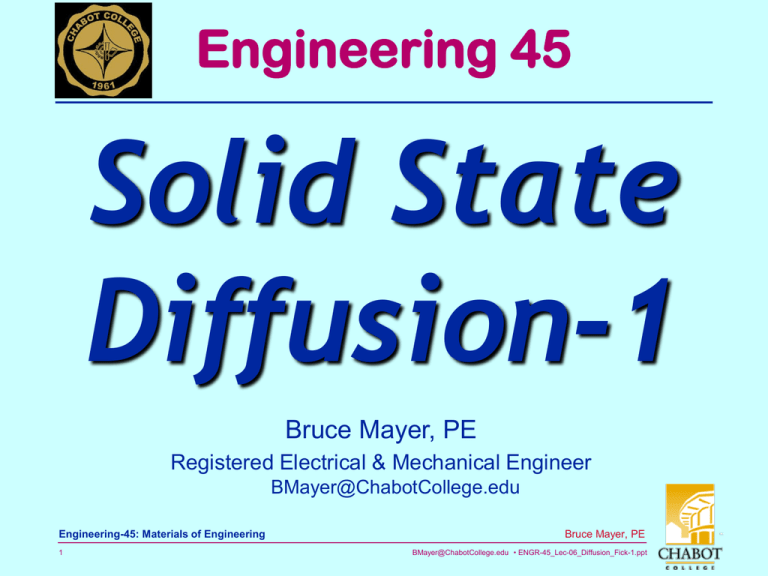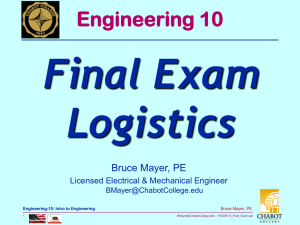Solid State Diffusion-1 Engineering 45 Bruce Mayer, PE
advertisement

Engineering 45 Solid State Diffusion-1 Bruce Mayer, PE Registered Electrical & Mechanical Engineer BMayer@ChabotCollege.edu Engineering-45: Materials of Engineering 1 Bruce Mayer, PE BMayer@ChabotCollege.edu • ENGR-45_Lec-06_Diffusion_Fick-1.ppt Learning Goals - Diffusion How Diffusion Proceeds How Diffusion Can be Used in Material Processing How to Predict The RATE Of Diffusion Be Predicted For Some Simple Cases • Fick’s FIRST and second Laws How Diffusion Depends On Structure And Temperature Engineering-45: Materials of Engineering 2 Bruce Mayer, PE BMayer@ChabotCollege.edu • ENGR-45_Lec-06_Diffusion_Fick-1.ppt InterDiffusion In a SOLID Alloy Atoms will Move From regions of HI Concentration to Regions of LOW Concentration Initial Condition After Time+Temp 100% Engineering-45: Materials of Engineering 3 0 Concentration Profiles Bruce Mayer, PE BMayer@ChabotCollege.edu • ENGR-45_Lec-06_Diffusion_Fick-1.ppt SelfDiffusion In an Elemental Solid Atoms are NOT in Static Positions; i.e., They Move, or DIFFUSE Label Atoms After Time+Temp C A D B How to Label an ATOM? • Use a STABLE ISOTOPE as a tag – e.g.; Label 28Si (92.5% Abundance) with one or both of 29Si → 4.67% Abundance 30Si → 3.10% Abundance Engineering-45: Materials of Engineering 4 Bruce Mayer, PE BMayer@ChabotCollege.edu • ENGR-45_Lec-06_Diffusion_Fick-1.ppt Diffusion Mechanisms Substitutional Diffusion • Applies to substitutional impurities • Atoms exchange position with lattice-vacancies • Rate depends on: – Number/Concentration of vacancies (Nv by Arrhenius) – Activation energy to exchange (the “Kick-Out” reaction) Engineering-45: Materials of Engineering 5 Bruce Mayer, PE BMayer@ChabotCollege.edu • ENGR-45_Lec-06_Diffusion_Fick-1.ppt Substitutional Diff Simulation Simulation of interdiffusion across an interface Rate of substitutional diffusion depends on: • Vacancy concentration • Jumping Frequency Engineering-45: Materials of Engineering 6 Bruce Mayer, PE BMayer@ChabotCollege.edu • ENGR-45_Lec-06_Diffusion_Fick-1.ppt Interstitial Diff Simulation Applies to interstitial impurities More rapid than vacancy diffusion. Simulation shows • the jumping of a smaller atom (gray) from one interstitial site to another in a BCC structure. The interstitial sites considered here are at midpoints along the unit cell edges. Engineering-45: Materials of Engineering 7 Bruce Mayer, PE BMayer@ChabotCollege.edu • ENGR-45_Lec-06_Diffusion_Fick-1.ppt Diffusion in Processing Case1 Example: CASE Hardening • Diffuse carbon atoms into the host iron atoms at the surface. • Example of interstitial diffusion is a case Hardened gear. Result: The "Case" is • hard to deform: C atoms "lock" xtal planes to reduce shearing • hard to crack: C atoms put the surface in compression Shear Resistant Engineering-45: Materials of Engineering 8 Crack Resistant Bruce Mayer, PE BMayer@ChabotCollege.edu • ENGR-45_Lec-06_Diffusion_Fick-1.ppt Diffusion in Processing Case2 • Doping Silicon with Phosphorus for n-type semiconductors: • Process: 1. Deposit P rich layers on surface. silicon 2. Heat it. 3. Result: Doped semiconductor regions. silicon Engineering-45: Materials of Engineering 9 Bruce Mayer, PE BMayer@ChabotCollege.edu • ENGR-45_Lec-06_Diffusion_Fick-1.ppt Modeling Diffusion - Flux Flux is the Amount of Material Crossing a Planar Boundary, or area-A, in a Given Time Flux is a DIRECTIONAL Quantity x-direction Unit Area, A, Thru Which Atoms Move Engineering-45: Materials of Engineering 10 Bruce Mayer, PE BMayer@ChabotCollege.edu • ENGR-45_Lec-06_Diffusion_Fick-1.ppt Concentration Profiles & Flux Consider the Situation Where The Concentration VARIES with Position • i.e.; Concentration, say C(x), Exhibits a SLOPE or GRADIENT Cu flux Ni flux x Concentration of Cu (kg/m3) C Concentration of Ni (kg/m3) Position, x The concentration GRADIENT for COPPER C Concentrat ion Grad x Engineering-45: Materials of Engineering 11 and dC lim ConGrad x 0 dx Bruce Mayer, PE BMayer@ChabotCollege.edu • ENGR-45_Lec-06_Diffusion_Fick-1.ppt Fick’s First Law of Diffusion Note for the Cu Flux • Proceeds in the POSITIVE-x Direction (+x) • The Change in C is NEGATIVE (–C) Experimentally Adolph Eugen Fick Observed that FLUX is Proportional to the Concentration Grad Engineering-45: Materials of Engineering 12 Cu flux Ni flux x C Position, x • Fick’s Work (Fick, A., Ann. Physik 1855, 94, 59) lead to this Eqn (1st Law) for J dC J D dx Bruce Mayer, PE BMayer@ChabotCollege.edu • ENGR-45_Lec-06_Diffusion_Fick-1.ppt Fick’s First Law cont. Consider the Components of Fick’s 1st Law dC J D dx J • Mass Flux in kg/m2•s • Atom Flux in at/m2•s dC/dx = Concentration Gradient Engineering-45: Materials of Engineering 13 Cu flux Ni flux x C Position, x • In units of kg/m4 or at/m4 D Proportionality Constant • Units Analysis 1 kg m3 D Jdx 2 m dC m S kg Bruce Mayer, PE BMayer@ChabotCollege.edu • ENGR-45_Lec-06_Diffusion_Fick-1.ppt Fick’s First Law cont.2 Units for D 3 1 kg m D Jdx 2 m dC m S kg m2/S D→ One More CRITICAL Issue dC J D dx The NEGATIVE Sign Indicates: Engineering-45: Materials of Engineering 14 Cu flux Ni flux x C Position, x • Flux “Flows” DOWNHILL – i.e., Material Moves From HI-Concen to LO-Concen • The Greater the Negative dC/dx the Greater the Positive J – i.e.; Steeper Gradient increases Flux Bruce Mayer, PE BMayer@ChabotCollege.edu • ENGR-45_Lec-06_Diffusion_Fick-1.ppt Diffusion and Temperature Diffusion coefficient, D, increases with increasing T → D(T) by: Qd D Do exp– RT D = diffusion coefficient [m2/s] Do = pre-exponential constant factor [m2/s] Qd = activation energy [J/mol or eV/atom] R = gas constant [8.314 J/mol-K] T = absolute temperature [K] Engineering-45: Materials of Engineering 15 Bruce Mayer, PE BMayer@ChabotCollege.edu • ENGR-45_Lec-06_Diffusion_Fick-1.ppt Diffusion Types Compared The Interstitial Diffusers 300 600 1000 10-8 1500 Some D vs T Data • C in γ-Fe D (m2/s) Substitutional Diffusers > All Three SelfDiffusion Cases 10-14 10-20 0.5 1.0 Engineering-45: Materials of Engineering 16 • C in α-Fe T(C) 1.5 1000 K/T • The Interstitial Form is More Rapid Bruce Mayer, PE BMayer@ChabotCollege.edu • ENGR-45_Lec-06_Diffusion_Fick-1.ppt STEADY STATE Diffusion Steady State → Diffusion Profile, C(x) Does NOT Change with TIME (it DOES change w/ x) • Example: Consider 1-Dimensional, X-Directed Diffusion, Jx J x(left) J x(right) x Concentration, C, in the box does not change w/time. For Steady State the Above Situation may, in Theory, Persist for Infinite time • To Prevent infinite Filling or Emptying of the Box Engineering-45: Materials of Engineering 17 Bruce Mayer, PE BMayer@ChabotCollege.edu • ENGR-45_Lec-06_Diffusion_Fick-1.ppt Steady State Diffusion cont Since Box Cannot Be infinitely filled it MUST be the case: J x left J x right Now Apply Fick’s First Law J x left dC D Jx dx right Thus, since D=const Engineering-45: Materials of Engineering 18 J x(left) J x(right) x dC dx left dC dx right Therefore • While C(x) DOES change Left-to-Right, the GRADIENT, dC/dx Does NOT – i.e. C(x) has constant slope Bruce Mayer, PE BMayer@ChabotCollege.edu • ENGR-45_Lec-06_Diffusion_Fick-1.ppt Example SS Diffusion Iron Plate Processed at 700 °C under Carbon rich Conditions at Right Find the Carbon Diffusion Flux Thru the Plate gas dC dx J x2 D x1 dC/dx f(x) • i.e., The Gradient is Constant Engineering-45: Materials of Engineering 19 dC dx Carbon deficient gas 0 x1 x2 For SS Diffusion J x1 D Steady State → CONST SLOPE x2 D=3x10-11 m2/s For const dC/dx dC dC C C 2 C1 dx x1 dx x 2 x x 2 x1 Bruce Mayer, PE BMayer@ChabotCollege.edu • ENGR-45_Lec-06_Diffusion_Fick-1.ppt Expl SS Diff cont Thus the Gradient C 0.8 1.2 kg m3 0.01 0.005m x Carbon rich gas kg m3 80 80 kg m 4 m Steady State → CONST SLOPE Carbon deficient gas 0 x1 x2 D=3x10-11 m2/s Use In Fick’s 1st Law dC J x D dx J x 3 10 11 m 2 s 80kg / m 4 Engineering-45: Materials of Engineering 20 or J x 2.4 109 kg m 2 s J x 2.4 g m 2 s Bruce Mayer, PE BMayer@ChabotCollege.edu • ENGR-45_Lec-06_Diffusion_Fick-1.ppt WhiteBoard Work Problem Similar to 5.9 • Hydrogen Diffusion Thru -Iron -Fe: = 7870 kg/m3 Engineering-45: Materials of Engineering 21 Bruce Mayer, PE BMayer@ChabotCollege.edu • ENGR-45_Lec-06_Diffusion_Fick-1.ppt







